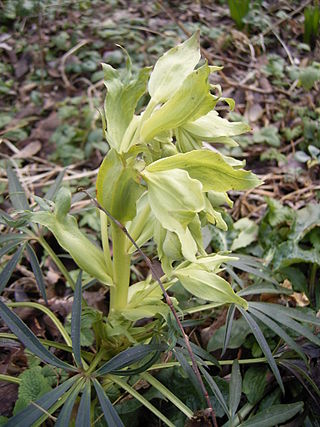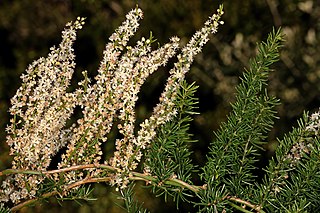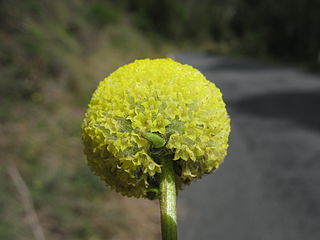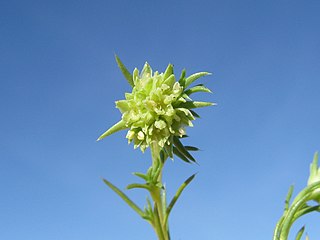
Eremophila is a genus of more than 260 species of plants in the figwort family, Scrophulariaceae all of which are endemic to mainland Australia.. Eremophilas are widespread in the arid areas of Australia, especially Western Australia and range in size from low-growing shrubs to small trees. The petals are joined, at least at their bases, into a tube with the upper petals different in size and shape from the lower ones. Some species have common names including emu bush, poverty bush or fuchsia bush, reflecting the belief that emus eat the fruit, their arid environment or a superficial resemblance to the flowers of plants in the genus Fuchsia.
Bolster heath or cushion moorland is a type of vegetation community that features a patchwork of very low growing, tightly packed plants found at the limits of some alpine environments. The cushion plants form a smooth surfaced 'cushions' from several different plants, hence the common name of cushion heath. The cushion growth habit provides protection against the desiccating wind and help keep the cluster warm.

Acacia ligulata is a species of Acacia, a dense shrub widespread in all states of mainland Australia. It is not considered rare or endangered. Its common names include sandhill wattle, umbrella bush, marpoo, dune wattle, small coobah, wirra, and watarrka.

Helleborus foetidus, known variously as stinking hellebore, dungwort, setterwort and bear's foot, is a species of flowering plant in the buttercup family Ranunculaceae, native to the mountainous regions of Central and Southern Europe and Asia Minor. It is found wild in many parts of England, especially on limestone soil.

Asparagus aethiopicus, Sprenger's asparagus, is a plant native to the Cape Provinces and the Northern Provinces of South Africa. Often used as an ornamental plant, it is considered an invasive weed in many locations. Asparagus fern, asparagus grass and foxtail fern are common names; however, it is unrelated to true ferns. A. aethiopicus has been confused with A. densiflorus, now regarded as a separate species, so that information about A. aethiopicus will often be found under the name A. densiflorus.

Scleranthus perennis, the perennial knawel, is a perennial herbaceous plant in the family Caryophyllaceae. It grows on sandy, dry, acidic soils. It can grow up to 15 cm high and has white flowers of 2–5 mm. The plant used to be economically significant as the major host plant of the Polish cochineal.

Leucopogon parviflorus, commonly known as coast beard-heath or native currant, is a shrub or small tree in the family Ericaceae. It is native to all Australian states and territories excluding the Northern Territory and the ACT and also grows in New Zealand. The species can grow to between 1 and 5 metres in height and has leaves that are 11 to 29 mm long and 2.4 to 7.5 mm in width, often with curved tips. The white flowers are around 15 mm long and are produced in spikes of 7 to 13. These occur throughout the year.

Olearia phlogopappa commonly known as the dusty daisy-bush or alpine daisy-bush is a species of flowering plant in the family Asteraceae that is commonly found in eastern New South Wales, Victoria and Tasmania. It is a small shrub with greyish-green foliage, daisy-like flowers in white, pink or mauve that can be seen from spring to late summer.

Astroloma humifusum, commonly known as the native cranberry or cranberry heath, is a small prostrate shrub or groundcover in the heath family Ericaceae. The species is endemic to south-eastern Australia.

Persoonia lanceolata, commonly known as lance-leaf geebung, is a shrub native to New South Wales in eastern Australia. It reaches 3 m (10 ft) in height and has smooth grey bark and bright green foliage. Its small yellow flowers grow on racemes and appear in the austral summer and autumn, followed by green fleshy fruits which ripen the following spring. Within the genus Persoonia, P. lanceolata belongs to the lanceolata group of 58 closely related species. It interbreeds with several other species found in its range.

Scleranthus annuus is a species of flowering plant in the family Caryophyllaceae known by the common names German knotweed and annual knawel. It is native to Europe, Asia, and North Africa, and it is known throughout the rest of the temperate world as an introduced species and a common weed. It grows in many types of habitat, often in disturbed areas.

Pittosporum bicolor, commonly known as cheesewood or banyalla, is a flowering shrub or small tree of the family Pittosporaceae, and is native to south eastern Australia.

Cassytha pubescens is a native Australian hemiparasitic vine species, in the Laurel family. Common names for the species include devils twine, dodder-laurel, spilled devil's twine, snotty gobble or downy dodder-laurel. It is a widespread and common species in south eastern Australia. The species was first formally described in 1810 by the Scottish botanist Robert Brown in Prodromus Flora Novae Hollandiae et Insulae Van Diemen. Leaves are reduced to scales and photosynthesis is achieved through chlorophyll contained in the plants stems. Stems are between 0.5mm and 1.5mm in diameter and the haustoria are between 2 and 3 mm long.

Persoonia chamaepitys, commonly known as the prostrate- or mountain geebung, is a shrub endemic to New South Wales in eastern Australia. It has a prostrate habit, reaching only 20 cm (7.9 in) high but spreading up to 2 m (6.6 ft) across, with bright green spine-like leaves and small yellow flowers appearing in summer and autumn.

Agastachys odorata, commonly known as the white waratah or fragrant candlebush, is the sole member of the genus Agastachys in the protea family. It is an evergreen shrub to small tree and is endemic to the heaths and button grass sedgelands of western Tasmania.

Craspedia variabilis, commonly known as billy buttons, is an erect annual or perennial herb which occurs in all mainland states of Australia except for the Northern Territory and in a wide range of habitats in temperate zones but not in alpine areas.

Persoonia terminalis, also known as the Torrington geebung, is a shrub belonging to the family Proteaceae, and native to northern New South Wales and southern Queensland in eastern Australia. Reported as a subspecies of Persoonia nutans in 1981, it was described as a species by Lawrie Johnson and his colleague Peter Weston in 1991.

Lysiana subfalcata, common name Northern mistletoe, is a spreading to pendulous hemi-parasitic shrub in the Loranthaceae which occurs in all mainland states of Australia except Victoria.

Juncus australis is a species of rush known by the common names austral rush, leafless rush and wīwī. The species is native to south-eastern Australia and New Zealand, where it can be found around bodies of water. Its habitat is wet or seasonally wet grasslands and woodlands, and it can grow in dense and damp soil along rivers and creeks. It is a rhizomatous perennial rush that grows up to 120 centimetres tall. The plant flowers in clusters, with dense heads at the tip of the stem.

Scleranthus diander commonly known as tufted knawel, is a flowering plant in the family Caryophyllaceae, it grows in eastern states of Australia and the Australian Capital Territory. It is a small, spreading herb with white or light green flowers.



















